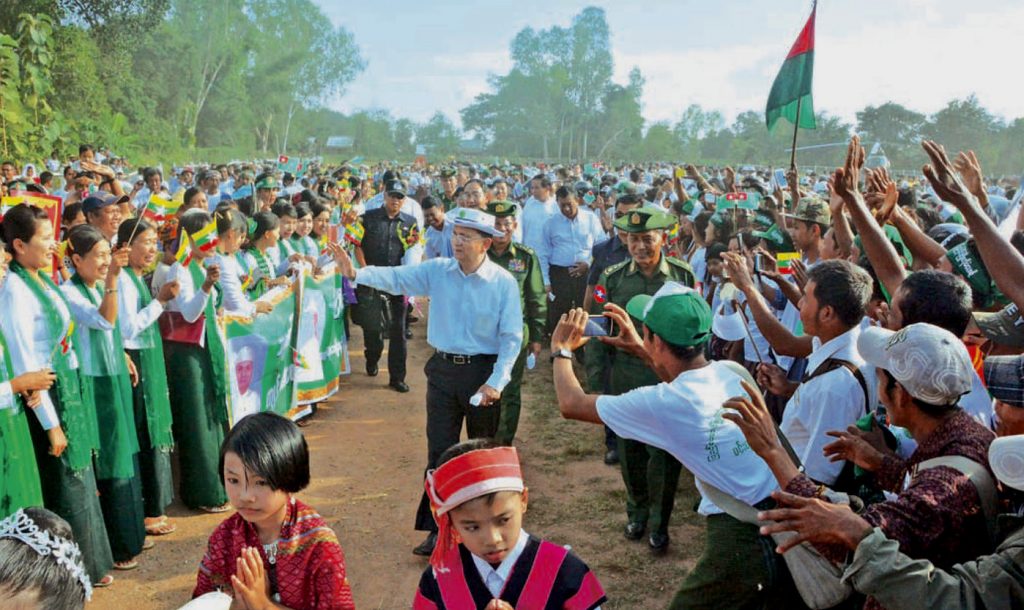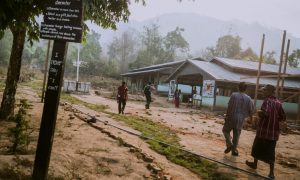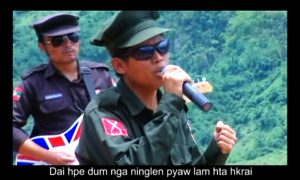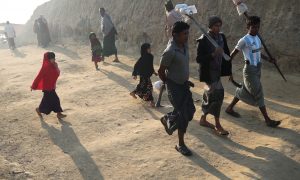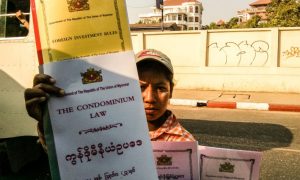It is strange that there is no serious domestic or international discussion of the democratic consequences of the Union Solidarity and Development Party (USDP) potentially being weakened after the 2020 general elections in Myanmar.
Serious albeit protracted peace negotiations are taking place between the Government of Myanmar (GoM), the Tatmadaw, and various ethnic armed groups (EAGs), all supposedly towards achieving federalism. The international community has also weighed in on the plight of Rohingya refugees, concerned with human rights and citizenship.
Notwithstanding the importance of federalism, human rights, and citizenship in themselves, all of these issues are all related to the most consequential political task at hand in Myanmar: democratic transition and institutionalisation. It will be difficult to achieve genuine progress on any of these fronts without first achieving an institutionalised democracy. For achieving an institutionalised democracy, the USDP may yet play an eminent role.
The experiences of other countries that have attempted to transition out of the military rule, much as Myanmar is currently endeavouring, suggest that the configuration of political parties and the security environment matter for the future of democracy. In this regard, the status of the USDP as a military proxy party is pertinent to the future of democracy in Myanmar.
The 2015 elections and their consequences
The State Law & Order Restoration Council (SLORC), the previous military regime, intended the USDP to be a ruling party driving the transition from direct military rule. The USDP, then called the Union Solidarity and Development Association (USDA), began as the military’s mass organisation in 1993. The regime contributed resources to develop the USDA’s organisation and presence throughout Myanmar, while repressing the activities of opposition parties, including the National League for Democracy (NLD). In 2010, the USDA was renamed as the USDP and registered as a party to contest the general elections. Together with another military-proxy party, the National Unity Party (NUP), it secured 70% of the votes in the 2010 general elections, which were boycotted by the NLD and other opposition parties, and became the ruling party during the transitional period between 2011 and the election of the current NLD-led government in 2016.
Although the USDP’s origins are intertwined with the military’s forays into politics, it is unclear to what extent the present-day USDP exists as an entity independent of the military’s sway. Regardless of the actual inner workings between it and the military, it is the public image of its continued association with the military that makes it salient to voters.
The USDP’s defeat in the 2015 general elections highlights the danger of this repeating in the 2020 general elections to Myanmar’s nascent democratic transition. In the 2015 elections, which the then-opposition NLD contested, the USDP secured less than 30% of the popular vote (translating to 8.4% of elected seats in the national parliament). The NLD won a landslide victory, securing almost 60% of the popular vote and 79.4% of elected seats.
The USDP’s drastically reduced presence in the national parliament, along with the constitutionally guaranteed 25% of parliamentary seats for the military, meant that the military effectively became the main opposition in the national parliament. The incoming NLD—whether strategically or not—also seems to have chosen to speak directly to the power behind the throne (i.e., the military) instead of sustaining a conversation with the real opposition party, the USDP. To a certain extent, talking directly to the military is inevitable, given its constitutionally guaranteed political role. The NLD may have also thought that engaging directly with the military would further democratisation. The wisdom of this choice in achieving a genuine democracy is yet to be seen.
Nonetheless, engaging directly with the military risks further weakening the USDP and the chances of democratic institutionalisation. The institutionalisation of democracy occurs when political parties and forces elect to contest through electoral means to achieve political representation, and parties rotate in office. The military, regardless of its power, coming from the 2008 Constitution and elsewhere, is not a political party. Engaging with the military, even if necessary, does not reinforce the electoral means of representation, whereas engaging with the USDP entrenches the democratic institutions of electoral contestation and representation.
The NLD’s direct engagement with the military owes as much to the USDP’s continued struggle to attract a solid social base as to any strategic choice by the NLD. The 2015 election defeat was not without precedent for the USDP. In a series of by-elections in 2012, the then-opposition NLD won almost all the available seats. In fact, one of the most noticeable patterns in Myanmar politics has been the enduring appeal of the NLD, along with the continued struggle for the military-proxy parties, whether the NUP in 1990 or the USDP in 2015.
Has anything substantially changed since the NLD become a ruling party in 2016 to break this pattern? The NLD government’s performance has so far failed to meet the great expectations of some. However, will this be enough for Myanmar’s ethnic Burman majority to hand the mantle to the USDP come the next election? Will rising nationalism work in the USDP’s favour?
Lessons from other countries
The experiences of other countries highlight the danger of a weak “authoritarian successor” party for a democratic transition. Democratic transitions in Asia have stressed the importance of moderation on the part of an authoritarian successor party that is enabled by the economic performance and the party’s strength. On the other hand, democratic transitions in Latin America and Sub-Saharan Africa suggest the importance of three conditions for democratic outcomes: the strength of the authoritarian successor party (in Myanmar, the USDP), the strength of the opposition (the NLD), and the security threat. Here, party strength means the strength of a party’s broad-based social support. Thus, it depends upon its linkages to society and its ability to mobilise the support of the latter. Security threats are the perceived risks by the party elites to their ability to attain and maintain power: coups, secessions, regional conflicts, and violence against the state.
In Asia, authoritarian successor parties in Taiwan, the Republic of Korea, and Indonesia facilitated democratisation through political and economic moderation. They broadened the political space for contestation while expanding social welfare programs, because they were confident that democratisation would not sideline them. The strong performance of national economies under their leadership prior to democratisation, as well as the parties’ stable social base and alliances, buttressed their confidence. In fact, they were able to withstand occasional electoral setbacks and thrive under democracy through reinvention and post-election bargaining. Thus, instead of becoming democratic spoilers, they became democratic stabilisers.
In Myanmar, for the USDP to withstand electoral setbacks, thrive under democracy, and not become a democratic spoiler, it must disproportionately rely upon the party’s strength, rather than its economic performance. Prior to democratisation, the military ruled Myanmar directly, not through an authoritarian ruling party. The economic performance of the country under its rule was disastrous rather than miraculous. Hence, the USDP cannot rely upon the “sellable past” to attract votes. Instead, it must focus on its linkages to society and elite alliances to thrive under democracy.
In Latin America, the strength of authoritarian successor parties and opposition parties together influenced the fate of democratic transitions. In the 1980s, some Latin American countries, including Brazil, El Salvador, Uruguay, Honduras, Paraguay, Bolivia, and Ecuador, experienced a “dual transition” to democracy and a market economy. However, by the 1990s these countries experienced social and democratic upheavals as societies responded to market orthodoxy. In Brazil, El Salvador, and Uruguay, strong authoritarian successor and opposition parties were able to embody the social support for, or opposition to, market orthodoxy. In Honduras and Paraguay, however, where the authoritarian successor parties were strong and opposition parties were weak, opposition parties in power were ousted through non-electoral means including a coup. In Bolivia and Ecuador, where authoritarian successor parties were weak, but opposition parties were strong, populists came into power, who circumnavigated electoral representation in favour of popular referendums.
The experiences of Latin American countries highlight the importance of alignment between political parties and public concerns for democratic outcomes. Where parties were able to align themselves with public concerns such as rising poverty, inequality or unemployment, political contestation took place through electoral means, and democracy was institutionalised. Where they were unable to align themselves with public concerns, democracy was threatened. In Myanmar, the programmatic development of political parties—i.e. the alignment between the party’s ideology and public concerns—remains weak across the board. Although the USDP enjoys relative strength in terms of organisational resources, its programmatic development remains weak.
In Sub-Saharan Africa, the strength of authoritarian successor parties together with security threats shaped democratic outcomes. In the 1980s-90s, many African countries transitioned towards democracy after the end of the Cold War in the face of external pressure. Countries such as Ghana, where authoritarian successor parties were strong and there was no security threat, transitioned towards stable electoral democracy. However, in countries such as Uganda with strong authoritarian successor parties in the presence of security threat, democratic transitions veered towards stable autocracy. In Zambia and other countries, weak authoritarian parties together with the absence of security threat led to the proliferation of parties and volatile electoral democracies. Finally, countries, such as Mali, with weak authoritarian successor parties and the presence of security threat experienced regime instability, i.e., frequent alternations between democratic and non-democratic types of government.
The experiences of Sub-Saharan countries suggest security threats as a major challenge to the institutionalisation of democracy. Security threats can pose different challenges to democracy depending upon the political party configurations.
To summarise: with the experiences in other countries as a backdrop, Myanmar seems to be a case of a transitional country with a relatively weak authoritarian successor party and the presence of security threats. The USDP continues to struggle to shed its public image of being associated with the military and to root itself firmly to segments of Myanmar society. Its immediate defeats in the first relatively free and fair elections in 2012 and again 2015 showcase this. On the other hand, the continuing civil war is the epitome of an existing security threat. Although each country has additional, unique circumstances, a young democracy in Myanmar may face challenges that beset democratic transitions in countries with similar party configurations and security threats as in Bolivia, Ecuador, and Mali.
Building an institutionalised democracy
For Myanmar to have better prospects for democratic institutionalisation, reducing the security threat and strengthening the USDP’s linkages to society are the keys. So far, both domestic and international actors have disproportionately poured efforts into reducing the security threat.
However, for democrats in Myanmar and elsewhere, ending the civil conflict is not enough to deepen democracy. The USDP must also emerge as a legitimate party, whether in power or in opposition, with a strong identification with certain public concerns and thus linkages to segments of society. The collaborative efforts to strengthen the USDP party’s linkages to society, however, seem limited. To concerned parties, this presents an opportunity to not only strengthen democratic institutionalisation but also shape the party ideology of the USDP.
Development partners can contribute towards democracy in Myanmar by strengthening its party system. In particular, the political parties have a long way to go towards developing party ideologies, programs, and platforms. Assisting them to develop these enhances their linkages to society. Political parties with stronger linkages to society are better equipped to mobilise political energy and channel it through electoral politics when strains and shocks such as rising inequality or economic downturns inevitably arise. A political system’s ability to channel political movements through electoral politics is directly linked to a democracy’s resilience.
In transitional countries such as Myanmar, authoritarian successor parties’ linkages to society, i.e. their strength, is particularly salient for the future of democracy, as we have seen with other countries. For the USDP, a key challenge is to broaden its social base in a way that recasts its public image. For the upcoming 2020 elections, the USDP may be considering using nationalism and its performance in office vis-à-vis that of the incumbent NLD to appeal to voters. There seems, however, to be very few programmatic activities at the grassroots level that establish its presence and mobilise support in both the short and long term. It may also make overtures to ethnic parties in hope of post-election bargaining. The USDP, however, may need an overhaul to remain relevant under democracy. The military’s willingness to tolerate the USDP’s reinvention, or the emergence of other viable “conservative” parties that are ideologically aligned with the old guard’s interests, is important.
Otherwise, the failure to strengthen the USDP’s linkages to society and its continued marginalisation after the 2020 elections may prove detrimental to the future of democracy. The NLD party may not fare as well as it did in 2015 in the areas where ethnic minorities are concentrated. An electoral upset in the form of a victory for the USDP in 2020, however, seems remote. The poor performance of the USDP in 2020 may mean that the NLD, other opposition and ethnic parties will continue to engage directly with the military, to the marginalisation of the USDP. This outcome will only entrench the military’s role in politics while weakening the development of the party system and thus the prospect for an institutionalised democracy.
 Facebook
Facebook  Twitter
Twitter  Soundcloud
Soundcloud  Youtube
Youtube  Rss
Rss 